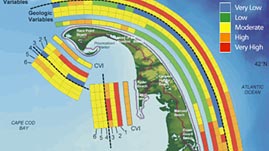Teachers' Domain - Digital Media for the Classroom and Professional Development
User: Preview

Source: National Park Service. Additional image courtesy of Del Norte County Historical Society.
Coastlines are places of continuous, often dramatic geological activity. Shaped by the actions of waves, tides, currents, and other forces, coastlines change daily and seasonally, but especially over long time periods. In this interactive resource adapted from the National Park Service, learn about the forces that help shape coastal landforms like cliffs and beaches.
Although development and other human activities have influenced our coastal environments, the natural processes of weathering and erosion are largely responsible for shaping coastlines. Weathering refers to the physical, chemical, and biological processes that disintegrate exposed rocks and minerals. Coastal weathering occurs most actively within the tidal range — the vertical distance between high and low tides. Water that lashes against coastal rock may react chemically with it and dissolve certain minerals. The salt in seawater can also accelerate weathering, as pressure created by the expansion of salt crystals left behind after evaporation in turn causes the expansion of small surface fractures in rocks. In addition, certain physical factors such as daily temperature fluctuations and the repeated wetting and drying of rocks can cause rocks to expand and contract, further weakening them.
Coastal erosion occurs when rock fragments loosened by weathering are transported away from the parent, or source, material. Ocean waves are the most important erosive agent along most coastlines. Generated by the action of wind blowing across the surface of the sea, waves do most of their erosive work in locations that are shallow and near the shore. As waves approach the shore, they increase in amplitude, or height. When they break onto the shore, the energy they carry is transferred to the land surface. The sediment they carry may further abrade any rock it encounters. The more wave energy that is released on shore, the larger the rock fragments it can move. Thus, in large storms when waves carry more energy, their erosive capacity is greater, and they are capable of splitting or moving large boulders.
Sediment eroded from the shore is carried away by ocean currents. Cross-shore currents, or undertow, form after waves crash on the shore and the water returns seaward due to the force of gravity. Longshore currents are created in part by waves that arrive at the shore at an angle. They move sediment parallel to the shore.
When waves encounter steep cliffs, they typically do not break, so much of their energy is reflected back to sea. As a consequence, the water has a negligible effect on the rock surface, and wave erosion happens much more slowly. Only high-energy conditions, such as storms, increase the effects of wave erosion on cliffs.
 Loading Standards
Loading Standards Teachers' Domain is proud to be a Pathways portal to the National Science Digital Library.
Teachers' Domain is proud to be a Pathways portal to the National Science Digital Library.
